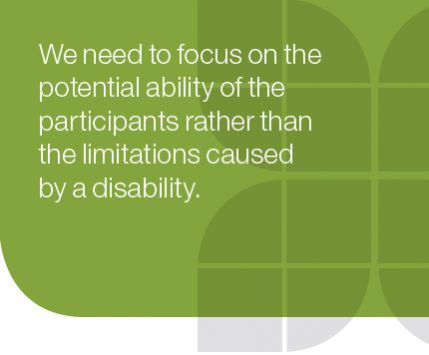For the purpose of this manual and to avoid confusion, the terms “inclusion” and “integration” are considered to be the same, and for the sake of consistency, inclusion has been used exclusively. We have the responsibility of providing an environment in which people with disabilities. are able to develop social skills, feel part of the group as equal participants, be included in decision making, be challenged and be adventurous.
A number of areas need to be considered in achieving the successful inclusion of a person with a disability into a community sport or active recreation program. The concept of ‘disability’ is synonymous with ‘ability’ when it comes to sport and active recreation activities. We need to focus on the potential ability of the participants rather than the limitations caused by a disability. This encourages the recognition of the potential of individual group members and the activities can be structured to achieve this potential.
People with disabilities are encouraged to become and remain valuable members of the community. In achieving this we talk about the concept of “universal design (UD)”. Sanford (1998) defines Universal Design principles as being an approach to creating everyday products and environments that are useable by all people to the greatest extent possible, regardless of age or ability. Universal Design principles steer away from the idea that barriers need to be removed or that people require extra help or skills to navigate their environment. It is important to note that Universal Design principles are there to assist everyone, not just those who have a disability. When providing Universal Design principles within sport and active recreation, it is important that an individual is not segregated or excluded. Seven principles of Universal Design exist that can be used as guidelines to measure the extent to which a program, building or product will be able to be used by the maximum range of people.
These principles are as follows:
- Equitable Use- The design or program is useful to people with diverse abilities.
- Flexibility in Use- The design or program accommodates a wide range of individual preferences and abilities.
- Simple and initiative in Use- Use of the design or program is easy to understand, regardless of the users experience, knowledge, language skills, or current concentration levels.
- Perceptible information- The design or program communicates necessary information effectively to the participant, regardless of ambient conditions or the participant’s sensory abilities.
- Tolerance for error- The design or program minimizes hazards and the adverse consequences of accidental or unintended actions.
- Low Physical Effort- The design or program can be used efficiently and comfortably and with a minimum of fatigue.
- Size and Space for Approach and Use- Appropriate size and space is provided for approach, reach, manipulation and use, regardless of a user’s body size, posture or mobility. (Copyright©1997 NC State University, The Centre for Universal Design)
These seven principles of Universal Design can assist in the implementation of programs and services to ensure accessibility for all. Below are examples of how they may be implemented in sport and active recreation programs and activities:
- Provide the same means of use for all users; identical whenever possible, equivalent where not.
- Avoid segregating or stigmatizing any users.
- Make the design of the program appealing to all users.
- Provide choice in method of use.
- Facilitate the participants’ accuracy and precision in an activity.
- Provide adaptability to the participant’s pace.
- Eliminate unnecessary complexity.
- Accommodate a wide range of literacy and language skills.
- Provide effective prompting and feedback during and after an activity.
- Use different modes for presentation of essential information such as rules or instructions.
- Provide fail safe features for all participants to ensure they have fun.
It is important to remember that people with disabilities have the same aspirations as people everywhere.
We all want to:
- get the most from life by finding opportunities for friendship, social life, and to participate in a wide range of interesting activities;
- achieve independence and a sense of worth;
- have a job and contribute to the community we live in; and
- have access to public transport, buildings and the community.
Through the concept of Universal Design principles, we institute a process of valuing individuals, encouraging growth through relevant learning situations using appropriate materials and activities. Further, the process provides realistic environments in which appropriate behaviours and attitudes can be observed and imitated.
Through participation in sport and active recreation activities, people with disabilities are assisted to develop the skills to effectively participate in the community. Using Universal Design principles in the design of a program, individuals are encouraged to look at similarities rather than differences, and to appreciate the diversity within our community. This provides for accessibility of all to community resources and activities.


